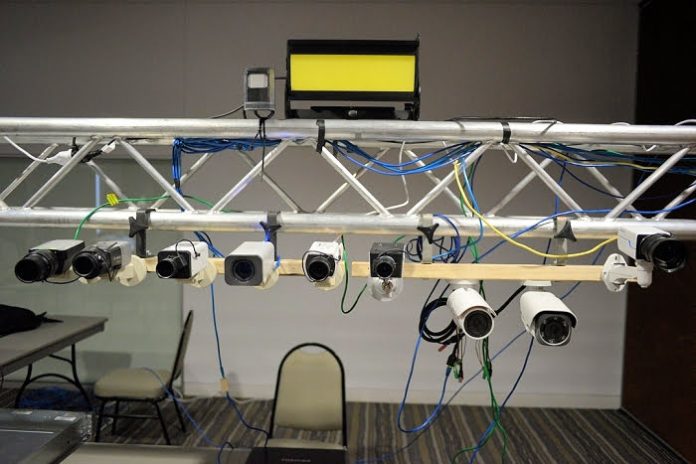HD cameras incorporate so many variables, from sensor type and processors to lens and compression engine, that making a balanced decision about what constitutes the ideal HD CCTV camera is an extremely difficult business.
WHEN it comes to choosing the best HD camera, where do installers, integrators, consultants and end users start? Is the best HD camera best in low light, best in strong backlight, or does it offer the most workable balance of both? Does the best camera have an adjustable CS-mount lens or can good performance come from the integrated lens of a tiny dome? Is it packed in an IP66 and IK10-rated housing or is it a full body?
Does the best HD camera offer 1.3MP of resolution or it have 3MP? Does it integrate most easily with any third party VMS solution or offer greater depth of integration with a proprietary VMS solution? Is it the camera with the most capable IVA? Does it have the lightest network footprint or the heaviest? Generate the least noise signal? Does the best HD camera cost the least money, or does it cost the most? And how about the ease of managing internal camera settings?
When you think about these questions, it becomes clear that choosing the best HD camera is a process that’s application subjective as well as performance objective. Constant changes in technology mean the definition of ‘best’ keeps moving forward. The best HD camera is going to be the camera that best melds a plethora of current functionalities with the demands of site and client, including budget. But having said this, there exists an HD camera that does it best of all.

For Bosch’s Steve Malesevic, the perfect HD CCTV camera has excellent dynamic range, excellent noise reduction, low bandwidth and the ability to be part of a transcoded video system. There are underlying camera qualities not front and centre on specification sheets – things like compression type/bandwidth demand across a range of scene types, processing power, lens quality, maximum operating temperature – that installers should be thinking harder about when they select cameras.
For Malesevic, the key characteristics for HD cameras are lens quality/lens selection for the application, dual power supply – PoE + VAC/VDC for redundancy and the ability to analytics at the edge.
“Lenses are very important,” says Malesevic. “Too often installers just go with the cheaper lens which compromises the image quality and consequently the cameras get blamed.”
According to Malesevic, something else to take into account it the cost/performance trade-off.
“There’s no point in having a noisy, blurry, dark image producing massive bandwidth consuming all of your storage and producing an unusable image,” he says. “The cheap price may win the job, but everyone gets a bad name in the process and the customer will never be happy.
“I think installers should ask themselves how happy or reluctant would they be to do a shootout for the customer in all conditions with a selection of cheap vs quality cameras? If an installer is all about just winning the job and is reluctant to perform a comparison, then if I were an end user, that would speak volumes.”
According to Damien White, surveillance product manager at CSD, there is no perfect HD CCTV camera as such.
“All manufacturers search for the perfect camera but that utopian camera is yet to be built,” explains White. “Features which are good for one environment may in fact be counter-productive in a different environment.
“But if I were to create a perfect camera it would have at least 2 streams, the main stream would be minimum 3MP @ 25fps, have great low light performance, include auto focus, have great WDR, have built-in analytics and be able to provide a good image of number plates behind even the brightest headlights.
“It would have edge recording which is able to be used as a buffer in the event of any network problems and would be able to have most statuses monitored using the Simple Network Management Protocol. My perfect camera would use next to no network bandwidth or power.”
When it comes to underlying qualities not front and centre on specification sheets installers should be thinking harder about when they select cameras, White nominates something rarely considered but vitally important.
“Compatibility with head end recording devices such as NVRs and VMS is extremely important and not often documented very well,” he says. “It normally takes a lot of hunting for information and testing to ensure a camera is compatible. Simply being an ONVIF compatible camera does not ensure 100 per cent compatibility and some camera features may not work with a particular VMS.
“Bandwidth requirements are also crucial when designing the network infrastructure, which will be supporting an IP CCTV system. I personally allow for the bandwidth required by the camera at full frame rate and quality.”
White too, considers lens selection paramount.
“Lens selection is extremely important,” he says. “Both field of view and lighting conditions must be taken into account. Some factory-fitted lenses, while being high quality and allowing for easy installation, are designed as a one size fits all approach and may be only suitable for 80 per cent of projects.
“For the other 20 per cent, it’s essential to take the time to choose the correct lens. Factors to consider are the field of view, lighting conditions and how many megapixels the camera has. I recently tested some lenses for low light conditions and had the opportunity to use the new Hikvison HV0733D-6MP F0.95 lens.
“When I compared this side by side with a good quality F1.5 lens the difference in low light performance was amazing with the image with the F0.95 attached to the camera being much brighter and clear with exactly the same camera and settings as the F1.5 Lens.”
White believes objective testing is the key to selecting the best camera for a given application.
“In my experience low cost does not mean low quality,” he says. “Objective testing HD cameras is extremely important as no one camera is suitable for all environments and the integrators need an independent method of ensuring they are choosing the best camera for the job. Shootouts at exhibitions and shows are a great way of doing this.”

For Andrew Cho, product manager at EOS Australia, the best HD camera is the camera that best meets the operational requirements of the client.
“A perfect camera is a camera which produces a usable and identifiable image in any environment or condition,” Cho says. “To provide a usable image the camera must have a good wide dynamic range, as well as good low light performance and noise reduction.”
“Installers selecting an HD IP camera need to consider total usage of multi HD stream profile based on FPS (some manufacturers promote their camera being a quad stream capable but in reality it may only do 1 HD stream at highest FPS and only allow low res stream for rest of streams,” Cho says.
“Something else that’s important is bandwidth utilization. Even at the same resolution and with the same codec, every manufacturer has its own way to slim total bandwidth usage. Lenses are also very important to bring out the optimum of the camera.
“Depending on the project, installers should consider using different type of lenses to suit the environment and cost. Some lenses do have rougher cutting compare to other reputable lens manufacturers and this usually results in poor performance of the camera.”
As we all know, price of HD cameras is a big deal in the current market. But past a certain point there’s a cost/performance trade-off in terms of elevated noise, poor low light performance, motion blur. But where do you think that point is – when is low cost no longer worth it? And given the challenge of finding the point where low cost might mean poor performance, how important is objective testing of HD cameras?
“One of key things in the current IP market is that customers believe high-resolution guarantees better performance and several manufacturers promote their cheap high-megapixel cameras based on this marketing strategy,” Cho says.
“However, usability of the image is not dependent on resolution only but also on a camera’s performance in a range of different and challenging environments. For example a 3MP camera may look better in normal conditions but a good 1.3MP camera can provide much more information in a situation with strong backlight or low light.”

Chris Tangsilsat, senior sales engineer at Axis Communications agrees that high performance is not necessarily about high resolution.
“An effective camera is not always about throwing more pixels into the situation,” he explains. “Surveillance takes place over a 24/7 period and it’s important to ensure that a usable image is always achieved.
“For instance, entry points subjected to strong glare/high contrast demand features WDR Forensic Capture. And general internal areas may only have minimal ambient lighting afterhours so in this case we may choose to go with a camera which focuses on LightFinder technology.
“Areas with almost no illumination at all such as server rooms when unoccupied would make use of a different set of features such as a camera with built in Optimized IR illumination,” Tangsilsat explains,
“Regardless of technology utilized, the key objective of each is to provide a clean usable image which will also ultimately also result in lower bandwidth and storage requirements.”
According to Tangsilsat, apart from the ability to handle a diverse range of lighting conditions, selection of the appropriate lens focal length and understanding the trade-off between field of view vs. pixel density also plays an important role.
“The most common resolution sold today is 1080p (1920×1080) as this today represents a good balance between resolution, low light performance and bandwidth and storage requirements,” he explains.
“Knowing that, it then becomes a task of deciding whether the user is after detection quality, which typically requires 25 pixels per meter = 76 meters coverage width; recognition, which is typically 125 pixels per meter = 15 meters coverage width; or identification, which is typically 500 pixels per meter = 3.8 meters coverage width.”
For Tangsilsat, lenses are one of the key areas installers should be considering.
“Lenses are one of the more crucial aspects when it comes to ensuring that a usable image is achieved, as a lens option must always be compatible with the selected camera model,” he says. “For example the basic factors to consider might be whether or not the lens is rated to the same sensor size as the camera – for instance is it 1/3-inch?
“Is the lens rated to the same resolution as the camera – for instance, 2MP? And if using a day/night camera with an IR cut filter, is the lens also IR-corrected? A mismatch in any of these basic criteria’s would severely degrade the image quality.”
Tangsilsat believes there’s always going to be a point of debate when it comes to having to choose between either investing more in the camera hardware for a better low light sensitive model vs. increasing the storage costs due to a higher level of noise in the image under low light conditions.
“This is why ensuring that the image is as clean as possible will provide 2 layers of benefits in both a more usable image along with lower storage requirements,” he explains.

Over at Hikvision, Michael Bates identifies a range of technologies that exemplify what he considers to be the perfect HD camera.
“The best HD cameras need to be able to perform well in a low light without motion blur and ideally, stay in colour,” says Bates.
“Hikvision’s Darkfighter range is certainly one of the best lowlight ranges on the market today in that regard.
“WDR has come a long way in recent times and Hikvision’s Lightfighter range has a massive 140dB of wide dynamic range. In fact, the entire Smart IP range has a minimum 120dB at 1080p. And while most manufacturers do WDR well at 720p, very few can sustain WDR performance at 2MP or 3MP as Hikvision does.
“While network speeds are increasing and servers are becoming more powerful, bandwidth still has a huge impact, so ways to minimise bandwidth are important,” says Bates. “Hikvision will soon be releasing Smart H.264 which will effectively halve bandwidth. Being a derivative of H.264 it will not need a full rewrite from the various VMS manufacturers. This technology will be fully backward compatible with Hikvision’s Smart IP range in the form of a firmware upgrade.”
When it comes to underlying qualities installers should be thinking harder about when they select cameras, Bates says the big one in his opinion is IVA.
“While edge analytics are listed on specification sheets, their applications and affects are too numerous to cover,” he explains.
“Hikvision has facial detection, people counting, heat mapping, trip wires and many more, so cameras can be used more proactively. Many of these features, when properly configured, can also dramatically reduce bandwidth usage. Lens selection is also very important. An excellent camera paired with the wrong lens can ruin your image quality.”
How important are lenses? Should installers be thinking about specific lenses for specific tasks?
“Hikvision believes that the lens is critical in maximising camera performance, to the extent that we bought a lens manufacturer to ensure that we could get the right lens in a timely fashion,” Bates says. “A great example is our new Darkeye lens, a 1/1.8-inch 7-33mm lens with F Stop of only 0.95. The Darkeye was designed specifically to make the Darkfighter low light camera go from outstanding to extraordinary.”
When it comes to price, Bates says Hikvision is setting the standard for the industry in terms of value for money.
“When cameras with comparable specifications are tested, Hikvision will invariably match or beat its competitors on performance at a significantly lower price point,” he says. “There is a huge range of cameras available these days and the critical element is choosing the right camera for your application and buying from a reputable manufacturer to ensure reliability. And IP cameras really are at a point where the costs are so close to formerly cheaper analogue technology that it makes no point to head down anything but the IP path.”

Bruce Maxwell (left), with Ben Sampson
Bruce Maxwell, national marketing manager at Seadan argues that the perfect camera is one that does not trade its highest specifications off against each other in real world applications.
“Most HD camera manufactures seem able to deliver a quality HD image (which is what the end user expects to see) and include WDR (earlier HD cameras often lacked WDR) but where trouble appears is the frame rate/resolution trade-off,” Maxwell says.
“You should expect to see full frame rate at maximum resolution but it’s common to see 3MP cameras with maximum frame rates of half real time. Want 25fps real time… sorry, best you can get is 2MP resolution! And a number of ultra high megapixel manufactures are offering frame rates as low as 6 fps, despite the fact our Dahua 12MP series IPC-HF81200E delivers real time at 12MP.”
When it comes to underlying qualities that might not seem important during the camera selection process, Maxwell says that probably the most important ‘secret squirrel’ attribute is bandwidth demand, which is difficult to actually measure and publish as it is scene dependant.
“No manufacturer would say their camera’s bandwidth demand was high in low light because there is no objective/agreed measurement reference. It would need an independent 3rd party to define the light level and object size/motion activity then to test a range of cameras under identical conditions.
“Technology limitations/cost trade-offs come into play here,” explains Maxwell. “As light levels in a scene decrease, the percentage of noise in the video increases and some processor chipsets interpret that as movement, reducing compression and consuming more bandwidth. The best way to resolve this potential issue is to try before you buy in as typical a range of scenes as you can get and then buy cameras from a manufacturer who gets it right.
Another big issue for Maxwell is lens quality.
“If you are only interested in viewing objects at the centre of the field of view, most lenses are quite good,” says Maxwell. “If you need to view objects of interest across the whole field, then lack of defects in the shaping, surface polishing and optical imperfections in the glass become very important.
“When you add the changes in geometry caused by internal movement in varifocal (multi-element) lenses, you create more potential error conditions. Low cost lens manufactures often label their products xMp where it is fair to say they will give you an image on say, a 3MP HD camera, just not a good one. This issue has always been with us but with HD the errors are easier for the integrator and end user to see.”
When it comes to low cost, says buying a product based only on low cost is never worth it. Maxwell believes that there is a point of value-performance trade-off but he says only objective testing would reveal it accurately.

Rob Rosa of QSS reckons that the perfect camera offers perfect colour reproduction in every environment.
“Colour reproduction is essential – a perfect camera reflects the true colours in a given scene,” he explains. “Ability to handle low light conditions and also shadows and other bright changes for example headlights coming towards a camera or a torch. Essentially many factors will be important but my view is that performance is site specific and project specific.
“For instance, in a casino environment colour reproduction is paramount yet it might be secondary on a factory floor that may not require such a high level of accuracy or detail. Today, many cameras are very good quality and have a tick in each box, so reality is that you buy what you like to install and as long as there is back-of-house support then you’re fairly safe.”
What about the underlying qualities of the camera that might installers?
“Frankly, as an ex-installer, ease of bolting a camera in and making it work is paramount,” says Rosa. “The longer this part of the process takes, the less time there is to muck around with pre-lens configuration and back-focus. One thing I have found lately is that some of the installers are complaining that the looms leading into the cameras are becoming bulkier and when they need to penetrate solid surfaces, this makes for a more time consuming and difficult job.”
Quality lenses?
“When it comes to lenses, again I see this as site specific and project specific – you need to meet client expectations,” he says. “Factory-fitted are fine for general day-to-day views and generally require less time mucking about. However, if you need to hit a sweet spot or you have ID, analytics and LPR requirements, then the lens is arguably more important than the camera selection, as long as you stick with the brand name cameras.
Is it true that past a certain point there’s a cost/performance trade-off in terms of elevated noise, poor low light performance, motion blur? If so, where do you think that point is – when is low cost no longer worth it? How important is objective testing of HD cameras in the current market?
“This is a great question that I think needs to be answered by the installers based on what value an end user places on quality and vs economy,” Rosa says. “Would you put a cheap brand in an area where security was critical and image quality, stability, lighting and bandwidth may be all major issues? I think the answer is obvious.
“Objective testing is very important, however, there are many people that do what I like to call subjective brand name testing which is not really a fair comparison between apples. Objective testing done properly is valuable data that gives installers the information they need to make a well informed decision on product selection.”

Neil Morgan, national products engineer at Ness says that the perfect camera is the perfect camera for the job.
“In general though, I would say that it should be aesthetically pleasing, vandal resistant, easy to adjust, and produce the best possible image under all conditions,” Morgan says. “Currently our IR Ball camera fits exceeds in all these areas.
“I think installers are largely guided by salesman in terms of what they consider to be the best solutions and certainly marketing hype where real needs are not always understood or asked about. We try to be as transparent and informative on our brochures as possible although the subjective camera image quality is impossible to describe on paper.
“I would always suggest that installers understand some of the most basic qualities about IP and camera technology and highlight WDR, low light noise, compression/image quality vs storage demand, lens quality, housing suitability, etc.”
“Lenses play a major part in image quality and once the camera sensor is over 3mp, lens quality really becomes a big issue,” says Morgan. “There are actually very few lenses on the market that are rated over 3MP on a 1/2.8-inch sensor because physics starts playing a major part in the equation, with diffraction affecting the image quality, let alone lens manufacturing quality at the price point needed.
“That said, the lenses built-in to our HD cameras these days are surprisingly capable at doing the job and are improving all the time. Probably the other biggest consideration at this point is compression because no matter how good the image quality is from the lens and sensor, compression will deteriorate it.”
According to Morgan, regardless of price, viewing and comparing cameras is important.
“We have always done this when we are choosing our range and are very confident when we display our cameras. What we see is that as well as image quality, it’s also the subtleties like camera housings, ease of mounting, backend performance, lenses etc. These subtleties will be the difference of double or quadruple the price and can be slightly hard to appreciate unless you need those specific features.

Sony’s Steve Charles says that under no circumstances should a camera’s resolution or performance be compromised by changing light conditions.
“If you buy an HD camera you want it to stay at its native resolution,” says Charles. “Most cameras these days have the ability to do many tasks such as Wide Dynamics, low light and other analytics however you shouldn’t have to trade off one or more of these features under different lighting conditions to maintain or sustain quality images.”
According to Charles, some camera manufacturers companies should look at their product performance specification sheets and come clean.
“Sony has at times not been considered for certain projects simply because our spec sheets are quite conservative, yet under shootout conditions we perform either equal to or better than the competitors,” he says. “There are outrageous claims of low light capabilities that hide extremely slow shutter speeds within their specifications – 10IRE @ 2.5 second shutter speeds for instance. I think that’s deceiving at best.”
How important are lenses really? Are factory fitted lenses fine, or should installers be thinking about specific lenses for specific tasks?
“Factory-fitted lens are very important when they are properly matched to the camera,” Charles says. “All Sony cameras with the exception of the SNCVB635 (High sensitivity camera) are supplied complete with a lens for this very reason. We have a list of approved lens and manufacturers models to suit specific installations.”
What about price – is there a point at which low cost impacts on performance?
“There are major issues with some low cost cameras particularly with SSL security issues, including vulnerability to bugs and attacks like Man in the Middle, Poodle, Shellshock and Heartbleed to name a few,” Charles says. “There are also inefficiencies of the codecs with some of the cheap cameras, as well as analytics trade-offs, and difficulty interfacing with open platform VMS.
“We have conducted various questionnaires worldwide and a common factor is price never rates at number 1 concern, usually rates down at 3 or 4. Image quality, reliability and ease of installation all rate higher.”
Lou Mavrelis of Hills rates consistency of performance as the key aspect of a perfect HD CCTV camera.
“Whether the camera is a full body or dome as a minimum it should produce a 1080p resolution image in real time,” says Mavrelis. “The camera must be able to work in low light applications and where IR is used, have a removable IR cut filter. For applications susceptible to high contrast backlighting, the added benefit of high wide dynamic range should also be considered.”
As do others, Mavrelis decries the trade-offs that are often seen in camera specifications.
“A lot of camera specifications will provide the highest values available for that particular feature which may appear to be great but have certain trade-offs which are not so obvious,” Mavrelis says. “What comes to mind is the number of 3MP cameras that are set at 2MP by default because they can transmit 2MP @ 30ips as opposed to 10~15ips @ 3MP and produce a better image in low light when set to 2MP rather than 3MP. Installers need to understand this and other settings that are dependent on the installation. I believe many are just installing the cameras in their default configurations and leaving them like that.”
Factory fitted or specific aftermarket lenses?
“Factory fitted lenses on cameras do provide better images than when compared to lenses that may be selected from the market,” says Mavrelis. “The problem is that the lens fitted may not suit the application required.
“As we see a decline in full body cameras, lens selection becomes more specialised as it is a requirement that the lens meet criteria for a particular application that a dome may not meet thanks to its pre-selected lens.
“When selecting a dome camera, installers need to understand that the greater the zoom lens, the greater the focus shift when putting the bubble back on the camera. To overcome this we are seeing more motorised zoom lens cameras that basically allow the installer to carry out a one shot focus after the field of view has been selected.”
Mavrelis believes camera performance and cost are connected.
“Camera performance is directly related to the cost,” he says. “It’s also worth noting that a low cost camera still has its applications especially in areas where high security is not a must but an acceptable image is sufficient. However, when an incident is being investigated, it always found that a higher performing camera would have produced a better result for the investigation team. In other words, you get what you pay for.”♦
By John Adams











